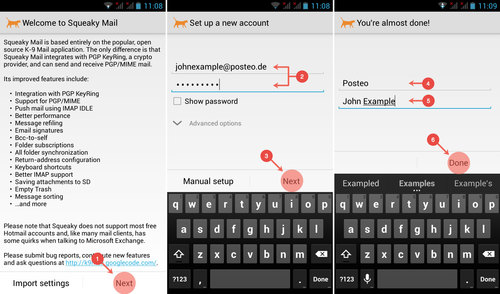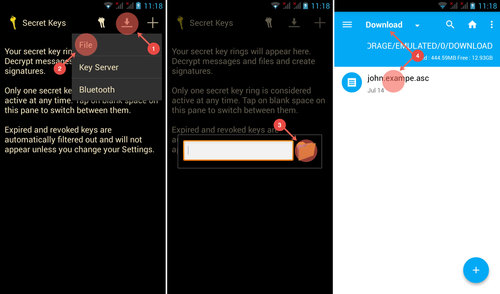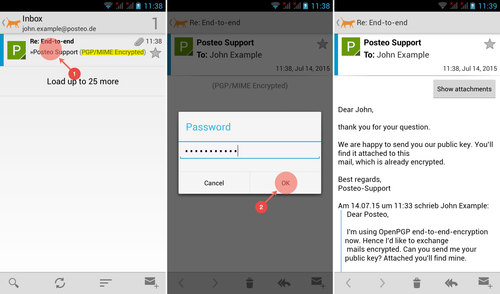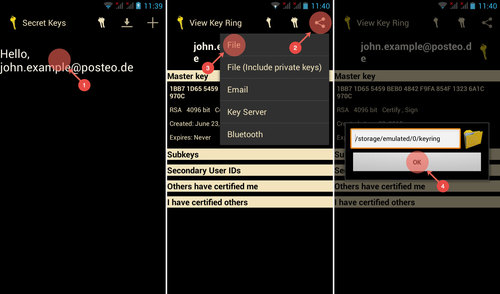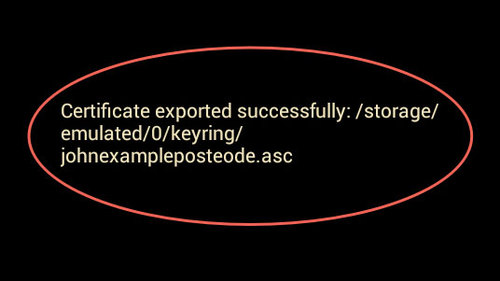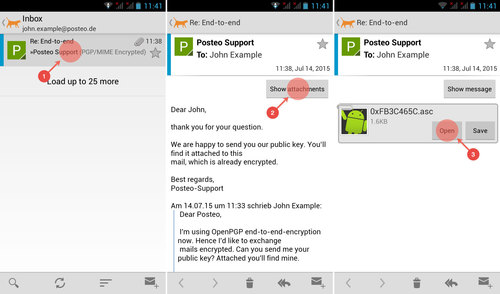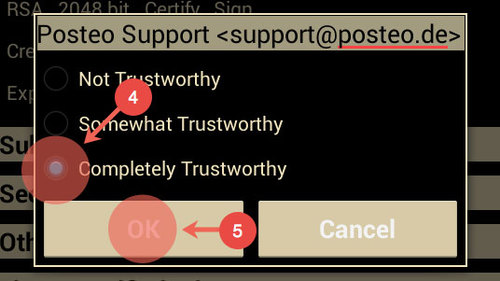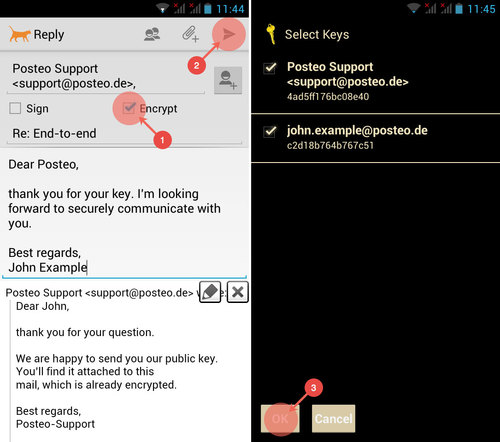To use OpenPGP encryption with support for PGP/MIME on an Android device, you will require additional apps from the Google Play Store. This help article explains OpenPGP encryption based on the apps Squeaky Mail and PGP KeyRing.
Before you begin: PGP KeyRing also exists as a free test version. In the test version, you can only use one private and two public keys. If you use Posteo’s inbound encryption and only require Squeaky Mail to read emails, the free version is sufficient.
In this help article we use the paid version of PGP KeyRing, for which the number of keys is unlimited.
Contents
- Setting up Squeaky Mail
- Setting up PGP KeyRing
- Reading PGP/MIME-encrypted emails
- Sending PGP/MIME-encrypted emails
- Alternatives to Squeaky Mail
- What about InlinePGP?
- Related help articles
1. Setting up Squeaky Mail
After you have installed all apps, first open Squeaky Mail. When started for the first time, a setup assistant helps you with configuration. The following steps are necessary to set up Squeaky Mail:
- Tap Next.
- Enter your Posteo email address and password.
- Tap Next.
- Enter a name for the account, e.g. Posteo.
- Enter the name with which you would like to send emails.
- Tap Done.
Setup of Squeaky Mail is now complete.
2. Setting up PGP
First, copy your OpenPGP key pair on the device. If you do not possess a key pair, yet, first create one using Enigmail or Mailvelope.
Copying a key pair on a smartphone or tablet
For security reasons, you should not send the key pair to the device by email. Instead, transfer the key pair via USB.
You can find out how to copy files to your Android device via USB in our help article Can I transfer files from my PC or Mac to my Android smartphone or tablet via USB?
We explain how to export an OpenPGP key pair in our help articles for Mailvelope and Enigmail.
Importing a key pair in PGP KeyRing
Once you have copied your key pair to the Android device, proceed as follows to import to PGP KeyRing:
- Open PGP KeyRing and tap the download symbol, to add a new private key.
- Tap File, to select a file on your smartphone.
- If you know the file’s location, enter it. Otherwise, tap the file symbol to select the file.
- In your file manager, (e.g. Amaze File Manager) select the folder with the key pair and tap the key file.
- The import is now complete.
Your key is now operational and you can close PGP KeyRing.
Common problem: If you receive an error message stating “I cannot handle that type of content” when importing, it means PGP KeyRing does not work with your file manager. Please install a different file manager, e.g. Amaze File Manager and repeat the process.
3. Reading PGP/MIME-encrypted emails
Once you have imported your key pair, you can then make emails readable. To do so, proceed as follows:
- Tap on the encrypted email.
- Enter your secret password to decrypt the email. Tap OK.
- Squeaky Mail now shows you the decrypted content.
4. Sending PGP/MIME-encrypted emails
If you have set up Squeaky Mail and PGP KeyRing, you can now send encrypted emails. To send an encrypted email, you will need the recipient’s public key. If you already have this, you can skip forward to the Sending encrypted emails section.
The easiest way to obtain someone’s public key is by asking them for it. Send your request along with your own public key. Then the recipient can encrypt their reply.
Exchanging keys – Step 1: Exporting the public key
- Open PGP KeyRing and tap your key.
- Tap the share symbol at the top right.
- Tap File, to save the key to your device. Important: Never circulate your private key “File (include private keys)”, even with your provider.
- Tap OK.
- You have now saved your public key on the SD card in the “keyring” folder.
Exchanging keys – Step 2: Sending the public key
To send your public key to another party, proceed as follows:
- To attach a file, tap the paperclip symbol at the top of the screen.
- In your file manager, select the folder containing your public key and select the file by tapping it with your finger.
- Remember to ask the recipient of your email for their public key and send the email.
Exchanging keys – Step 3: Importing keys
If you receive a public key by email, you will first need to import it in PGP KeyRing. To do so, proceed as follows:
- Open the email.
- In the email, tap show attachments.
- Tap open. Squeaky Mail automatically recognises the key and opens PGP KeyRing, to import the key.
- If everything worked, PGP KeyRing will show you that the key was successfully imported.
Finally, you need to declare that you trust the imported key.
- Open PGP KeyRing and tap the symbol with two keys.
- Tap the email address.
- On the following screen, tap the email address again.
- Select the level of trust.
- Tap OK.
Sending encrypted emails
After completing the key exchange, you can send encrypted emails. To do so, proceed as follows:
- Place a tick next to encrypt.
- Click the send arrow.
- Select the relevant key and confirm by tapping OK.
Important: When sending, make sure to select the recipient’s key and your own key. Then the encrypted email will also be stored readable for you in the sent folder.
5. Alternatives to Squeaky Mail
As well as Squeaky Mail, we are aware of two other apps that also support PGP/MIME: R2Mail2 and MailDroid (together with the Flipdog Crypto Plugin).
6. What about InlinePGP?
PGP/MIME is the modern successor to InlinePGP and in particular, simplifies the situation with attachments. For this reason, PGP/MIME is also used for our inbound encryption. If you receive InlinePGP-encrypted emails, this does not constitute a problem. Squeaky Mail also decrypts InlinePGP-encrypted emails.

